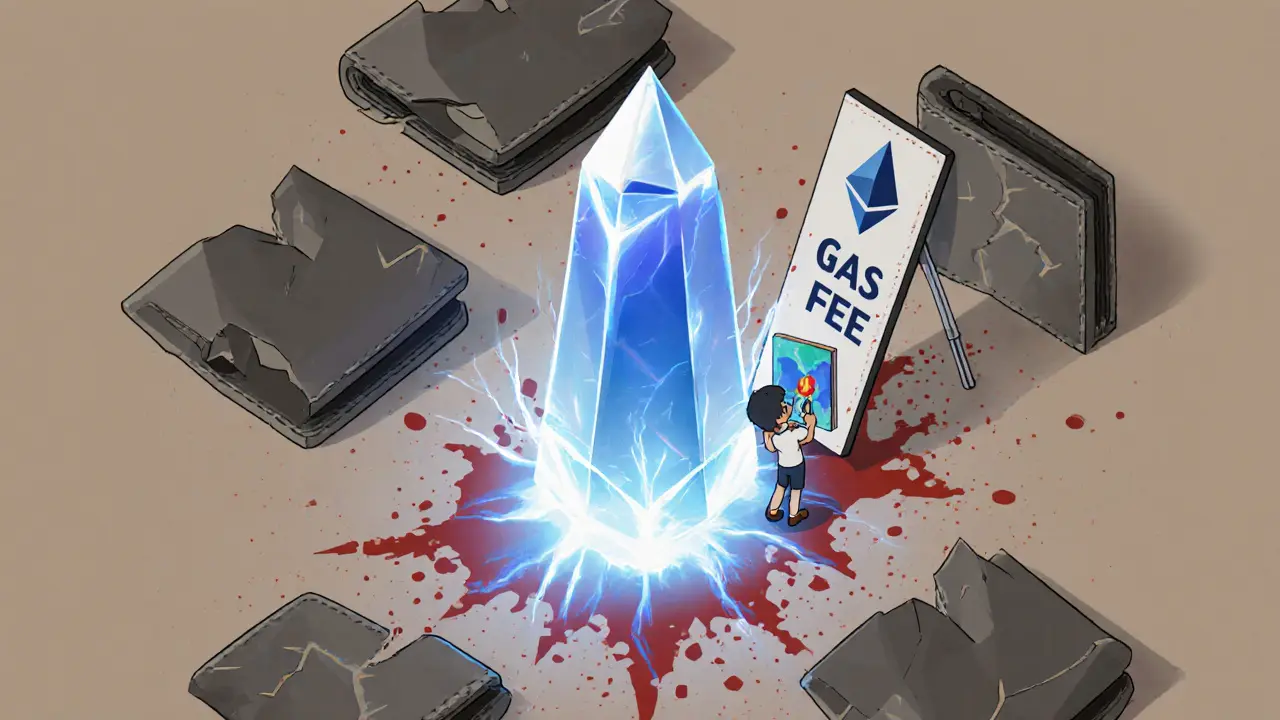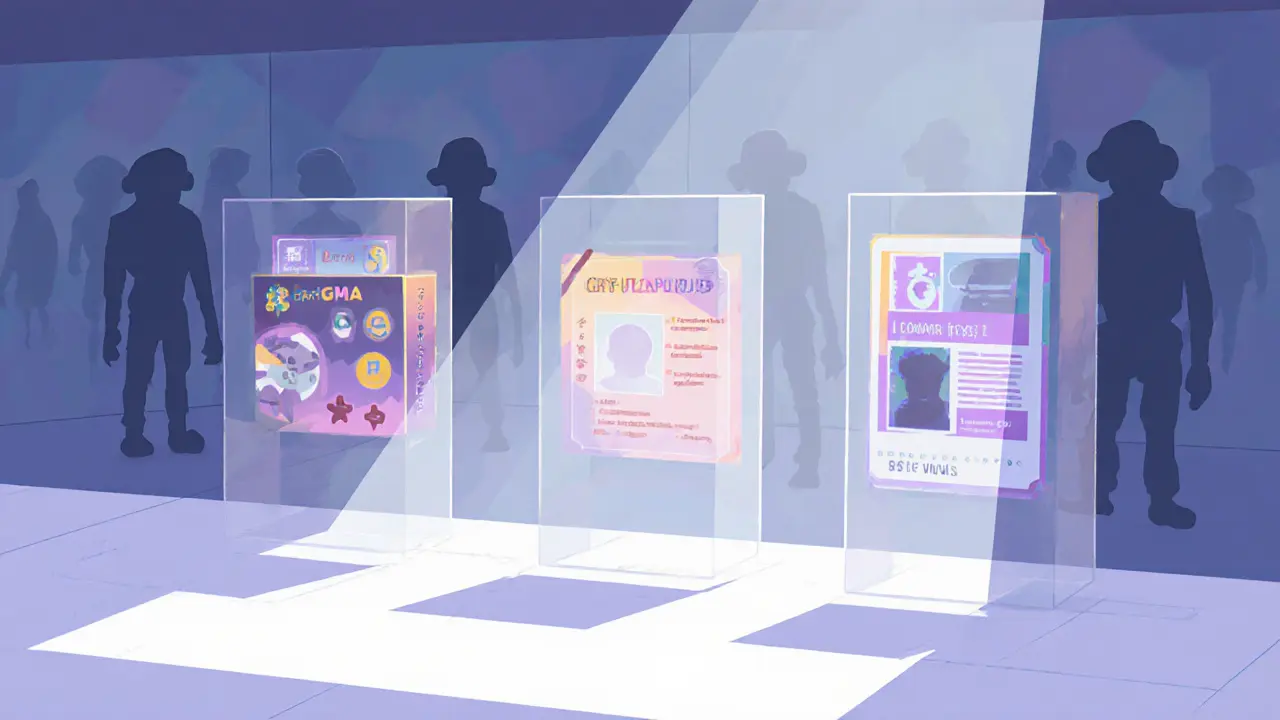NFT Profit/Loss Calculator
The NFT market didn’t just dip-it crashed. In late 2021, you couldn’t scroll through social media without seeing someone flaunt a Bored Ape or CryptoPunk worth hundreds of thousands. By mid-2022, those same NFTs were sitting unsold, with prices slashed by 80%, 90%, even 95%. What happened? It wasn’t one thing. It was a perfect storm of hype, economic pressure, bad practices, and broken promises.
How High Did It Go?
In early 2021, NFTs were still a niche curiosity. By November 2021, the market hit a peak of $3 billion in monthly trading volume. Christie’s auctioned Beeple’s digital artwork for $69 million. Celebrities like Snoop Dogg and Paris Hilton jumped in. Luxury brands like Gucci and Dolce & Gabbana launched NFT collections. NBA Top Shot sold digital highlights like rare trading cards, and fans paid thousands for clips of LeBron James dunks. The frenzy felt like the dot-com boom all over again-except this time, you weren’t buying a company. You were buying a JPEG.The numbers were insane. One CryptoPunk sold for $11.8 million. A single Bored Ape went for over $3 million. Investors believed these weren’t just art-they were digital real estate, future-proof assets that would only rise in value. But behind the scenes, much of that activity wasn’t real.
The Bubble Was Built on Wash Trading
A huge chunk of the trading volume wasn’t from real buyers. It was from wash trading-where the same person or group buys and sells the same NFT between multiple wallets to make it look like there’s demand. This trick fooled new investors into thinking a collection was hot. Platforms didn’t stop it. In fact, some even rewarded high-volume sales with featured listings.When the money stopped flowing, the illusion vanished. By June 2022, daily NFT sales had dropped 92% from their peak. The number of buyers fell by 25%, sellers by 36%. And here’s the kicker: the average time people held onto their NFTs jumped by 55%. They weren’t selling because they couldn’t-no one was buying.
The Economy Hit Back
While people were buying NFTs like they were lottery tickets, the real world was falling apart. Inflation hit 9.1% in June 2022-the highest in 40 years. Gas prices soared. The S&P 500 dropped 23% from its late 2021 high. People weren’t just losing money in the stock market-they were losing their jobs, their savings, their ability to pay rent.When that happened, NFTs were the first thing to go. They weren’t essential. They weren’t backed by cash flow or dividends. They were pure speculation. Investors who had poured money into NFTs during the boom suddenly needed cash for groceries, bills, or medical bills. So they sold. But with no buyers, prices collapsed.

Gas Fees Killed the Small Players
Most NFTs ran on Ethereum. And Ethereum was expensive. Minting a single NFT could cost $50-$100 in gas fees. Selling it? Another $30-$50. For a $200 NFT, that meant you lost 25-50% of your value just in transaction costs. If you bought an NFT for $500 and wanted to sell it for $600, you’d walk away with $500 after fees. Why bother?That made it impossible for small creators and casual collectors to participate meaningfully. The market became a playground for the wealthy-those who could afford to lose thousands without blinking. When the bubble burst, the middle class of NFT investors vanished. They never had a real chance to win.
Environmental Backlash
Ethereum used proof-of-work, the same energy-heavy system Bitcoin uses. A single NFT transaction consumed as much electricity as an average U.S. household in a week. As climate awareness grew-especially among younger buyers-the moral cost of owning an NFT became harder to ignore. Critics called it digital pollution. Some schools, universities, and eco-conscious brands pulled out. The backlash didn’t kill the market, but it chipped away at its credibility.Regulators Started Watching
Governments didn’t care about NFTs until people started losing money. Then, suddenly, they did. The SEC began investigating whether certain NFTs qualified as unregistered securities. Tax agencies started asking: How do you report a $10,000 NFT sale? Do you pay capital gains? What if you bought it with crypto? The lack of clear rules scared off institutional investors-banks, hedge funds, family offices-who might have stabilized the market. Instead, they stayed away.
Who Got Hurt?
Artists who spent months creating digital collections saw their income vanish overnight. One painter told me she made $12,000 in a single week in January 2022. By July, she hadn’t sold a single piece in six months. Collectors who bought NFTs at the peak lost most of their money. One Reddit user posted that he spent $80,000 on Bored Apes. Two years later, they were worth $8,000. He didn’t sell-he just stared at them.Investment funds that bet big on NFTs took massive write-downs. Some shut down entirely. The hype machine that promised riches to everyone had left behind a graveyard of wallets with worthless JPEGs.
What’s Left?
The NFT market didn’t die. It shrank. And in the wreckage, something quieter emerged. Projects that focused on utility-like NFTs that grant access to real-world events, unlock gaming items, or act as digital IDs-started gaining traction. Gaming companies began integrating NFTs into playable assets, letting players own and trade in-game gear. Some music artists use NFTs to give fans exclusive tracks or concert tickets.But the wild, get-rich-quick energy? Gone. The market now moves slowly. Sales volumes are a fraction of what they were. New projects are fewer. And the people still buying? They’re not speculating. They’re collecting. They believe in the tech-not the price tag.
Was It All for Nothing?
No. The crash was painful, but necessary. It cleared out the fluff. The scams. The empty hype. What remains is a foundation that might actually be useful. Digital ownership isn’t dead. It’s just waiting for the right applications to grow around it-ones that solve real problems, not just feed greed.The lesson? If something sounds too good to be true, and everyone’s talking about it, it probably is. NFTs aren’t magic. They’re code. And code doesn’t create value-people do. When people stop believing, the value disappears. Fast.
Did NFTs completely disappear after the crash?
No. NFTs didn’t disappear-they shrank. Daily sales dropped by over 90% from their 2021 peak, but trading never fully stopped. Projects with real utility-like gaming assets, event tickets, or digital identity tools-continued to sell. The difference? People aren’t buying them hoping to flip them for profit. They’re buying because they actually want to use them.
Why did NFT prices drop so fast?
Three main reasons: First, the market was built on hype and fake volume from wash trading. Second, inflation and stock market losses forced people to sell assets to cover living costs. Third, high Ethereum gas fees made selling small NFTs unprofitable. When the money stopped coming in, the whole structure collapsed under its own weight.
Who made money from the NFT crash?
Early adopters who bought NFTs before 2021-like those who got CryptoPunks for under $100-still held onto profits. Some artists who sold early and moved on also cashed out. And a few traders who shorted NFTs or sold before the peak made big gains. But for the vast majority who jumped in at the top? They lost money.
Are NFTs still worth buying today?
Only if you’re buying for use, not speculation. If you want an NFT that unlocks a game item, a concert ticket, or a membership to a community, it might be worth it. If you’re hoping to buy a JPEG and sell it for 10x in a month? Forget it. The days of quick NFT flips are over. The market is now focused on utility, not hype.
Will NFTs ever bounce back like they did in 2021?
Not like that. The 2021 boom was fueled by easy money, celebrity hype, and zero regulation. That environment won’t return. Future growth will be slower, driven by real applications in gaming, digital rights, and identity-not by viral tweets and FOMO. The NFT market is maturing. It’s not dead. It’s just grown up.

Natalie Nanee
November 7, 2025 AT 17:09The NFT market was a glorified Ponzi scheme dressed up as art. People were paying millions for JPEGs while rent went up and groceries got more expensive. It wasn't just stupid-it was immoral. No one should be this detached from reality.
Angie McRoberts
November 9, 2025 AT 14:43lol remember when I bought a Bored Ape for $4k and now it’s worth $120? I just keep it as a reminder not to trust hype. Also, my cat now has a better digital presence than I do.
Chris Hollis
November 11, 2025 AT 00:30Wash trading was everywhere. Platforms knew. Regulators looked away. Investors got played. End of story. No one’s surprised. No one’s responsible.
Diana Smarandache
November 12, 2025 AT 17:14This collapse was inevitable. The entire structure was built on vanity, greed, and a complete disregard for economic fundamentals. The only thing more tragic than the crash is how many people still defend it.
Allison Doumith
November 14, 2025 AT 16:32It’s not about the NFTs it’s about what they revealed about us. We wanted to believe in digital immortality. We wanted to own something that couldn’t decay. But the truth is we were just trying to fill a spiritual void with blockchain. And when the lights went out we realized we were holding empty frames.
Scot Henry
November 15, 2025 AT 09:44gas fees were the real killer. I tried minting a few pieces and spent more on fees than I made. It’s like paying $50 to sell a $100 t-shirt. No wonder the little guys got crushed.
Sunidhi Arakere
November 15, 2025 AT 16:34Market was too fast. People did not understand technology. Only wanted to make money. Now it is slower. Better.
Vivian Efthimiopoulou
November 15, 2025 AT 22:19What we witnessed was not merely a market correction-it was a collective reckoning with the illusion of value. The NFTs were mirrors, reflecting our deepest desires for legacy, ownership, and transcendence. And when the mirror cracked, we saw not a masterpiece, but a hollow echo of capitalism’s most grotesque impulses. The survivors? Those who sought meaning, not metrics.
Becca Robins
November 16, 2025 AT 23:41remember when i spent 2k on a monkey pic and now it's worth less than my coffee? 😭 still think it's kinda cool tho
Alexa Huffman
November 17, 2025 AT 16:42As someone from India, I watched this with fascination. The West treated NFTs like a new religion. Here, people were just trying to get internet access. The gap between hype and reality has never been wider.
Arjun Ullas
November 18, 2025 AT 11:28The NFT collapse was not a failure of technology but a triumph of rationality over spectacle. The market has now returned to its true purpose: enabling verifiable ownership, not speculative gambling. The future belongs to utility, not vanity.
Steven Lam
November 18, 2025 AT 21:14everyone was acting like they were gonna be billionaires but then the bills came due and suddenly your monkey pic is just a meme
Noah Roelofsn
November 20, 2025 AT 19:28The real story isn’t the crash-it’s the quiet resurrection. Projects that survived didn’t do it by shouting louder. They did it by building tools: game assets that persist across servers, tickets that can’t be forged, memberships that unlock real experiences. That’s the future. Not JPEGs. Not hype. Just functional, elegant digital infrastructure.
Sierra Rustami
November 21, 2025 AT 04:18America created this mess. We turned everything into a gamble. NFTs? Just another casino. The world’s watching and laughing.
Glen Meyer
November 21, 2025 AT 10:12they said it was the future but it was just rich guys laundering money through cartoon apes. Now the whole thing’s a punchline. And honestly? Good riddance.